So often, extraordinary things come from humble beginnings…
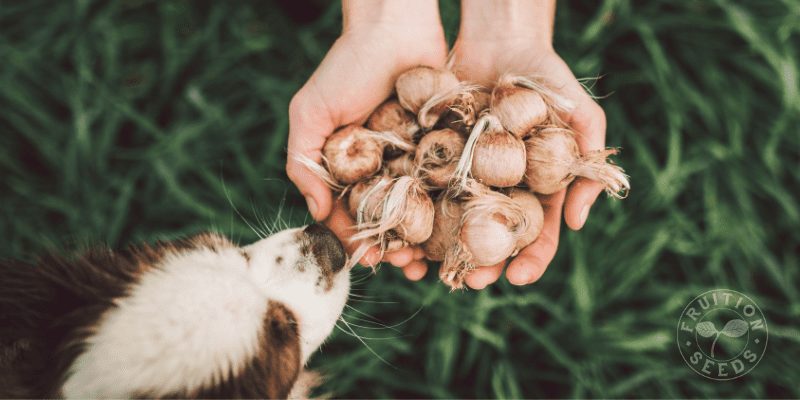
…and saffron is no exception!
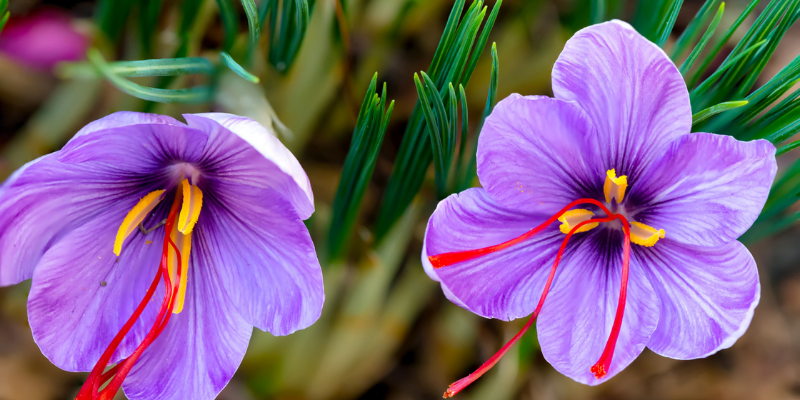
We love to push the envelope of what we can grow here in Zone 5 and a few years back we decided to plant a few saffron crocus corms to see what would happen. Lo and behold, we were blown away. They’re so easy to grow, perennial and so beautiful, not to mention delicious! We’re honored to finally share our gorgeous organic saffron crocus corms with you!
Though it takes ~75,000 blossoms to grow one pound of saffron, you can easily grow plenty for your own enjoyment with a handful of corms, and I hope that you do!
Before we dive in, know we made an entire mini-course, totally free, to set you up for success! Fruition’s Grow Your Own Saffron Mini-Course surrounds you with the knowledge and joy as well as confidence to

Saffron crocus bloom in fall with lusciously long ochre-orange stigmas (saffron!) emerging alongside yellow, pollen-rich anthers.
Here are the keys to keep in mind:
When to Sow Saffron Crocus
Saffron crocus are fall-sown, ideally 2 months before snow accumulates, though they can be sown anytime before the ground freezes. The earlier you plant your corms in that first year, the more saffron you’ll harvest in that first year! If you plant them within a month of serious frosts and snowfall, you may not harvest any saffron that first season, though you’ll harvest all the more in the seasons to come.
How to Plant Saffron Crocus
Plant your saffron crocus corms at least four if not six inches beneath the soil surface — deeper than you think! The richer the soil, the more abundantly your saffron crocus will bloom as well as divide. We incorporate 2-3 inches of compost in addition to Fruition’s organic granular fertilizer, feeding our soil as well as our crocus.
When to Harvest Saffron Crocus
Saffron is a fall-blooming rather than a spring-blooming crocus. Once their vivid plum blossoms open, harvest the long, ochre-orange stigmas (adjacent to the yellow, pollen-laden anthers) in mid-morning, once the dew has lifted, and dry them to enjoy for seasons to come.
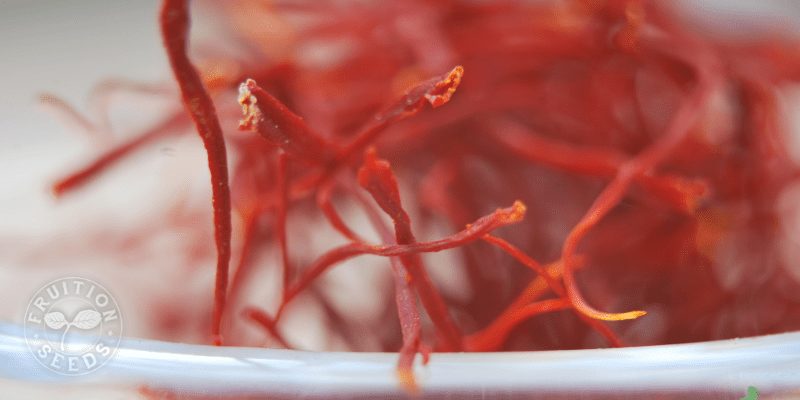
What to Expect in Seasons to Come
Once your saffron crocus blossom in fall and are covered in snow, wish them a long winter’s nap and don’t think twice, just like your garlic! Six inches of mulch around them will minimize frost-heaving while suppressing weeds & retaining even moisture.
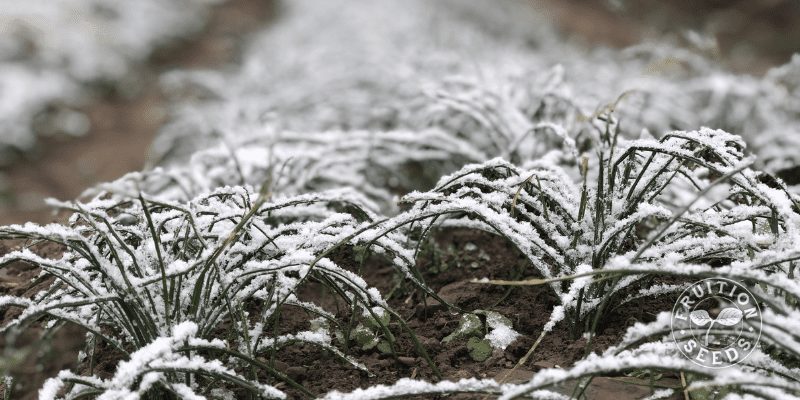
In spring, your saffron crocus will spring back to life, her glossy green leaves verdant even in the snow. By early summer, these leaves will turn yellow and die back, going into dormancy. Keep your saffron crocus well fed and weeded throughout the summer (six inches of mulch makes weeding easy!) and keep an eye for their leaves emerging once again in September here in Zone 5, once temps begin to dip again.
Saffron Crocus in Containers?
Yes! Just make sure that your containers are large — we grow saffron crocus in our 15-gallon fabric containers — if you’re in Zone 5 or colder, bring your crocus into an unheated garage or another place where they will remain cold but not exposed to the desiccating winter winds after they’ve flowered. Bring them back out after the snows melt in spring and you’re sowing your first peas!
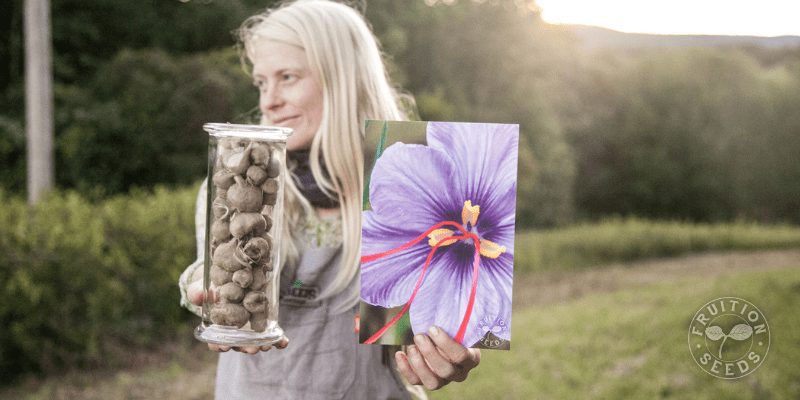
Fruition shares our organic saffron crocus in bags of 20 corms, arriving with one of these handy cards (front side above, back below) to keep by your side:
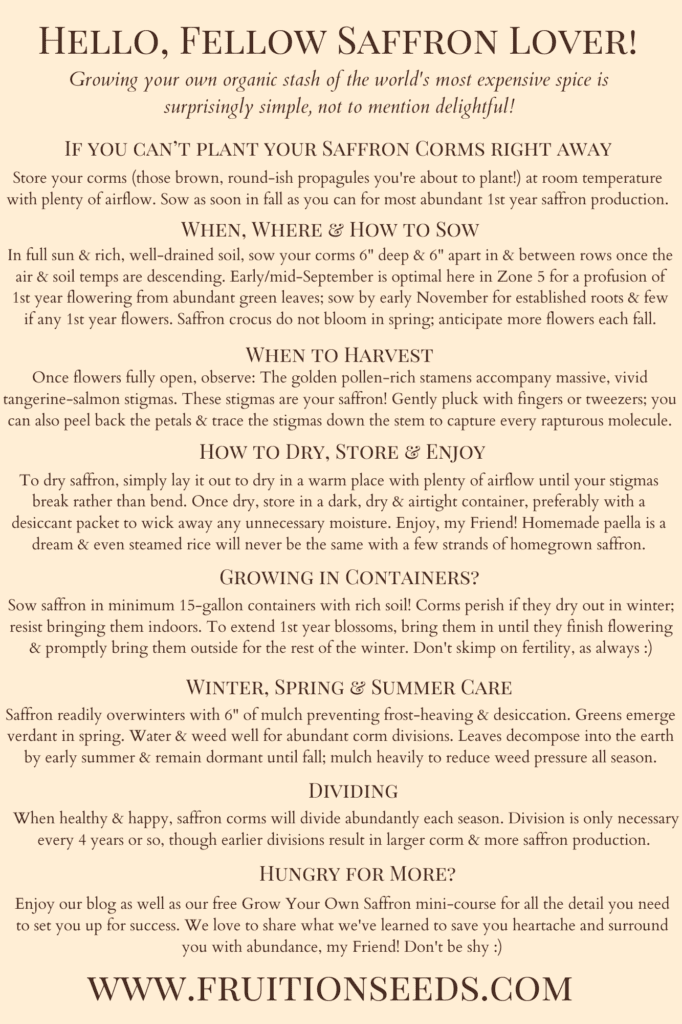
Hungry for more?
Enjoy our Grow Your Own Saffron Mini-Course, short and sweet as well as totally free, to set you up for success! We love to share what we’ve learned to save you heartache and surround you with abundance, my Friend.
Sow Seeds & Sing Songs,

and the Many Beings of Fruition
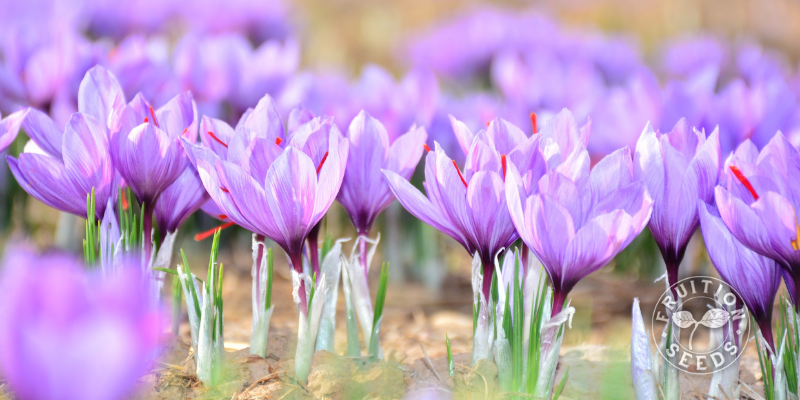
Transcript of Video:
I love crocus and I love saffron! And a number of years ago, I got really curious, and lo and behold, you can totally grow saffron crocus, here in the Finger Lakes and in Zone 5, in our short seasons. So here’s a few things to keep in mind as you embark on this journey. And I’m so excited for you!
So first and foremost, a little goes a long way. So yes, it takes 75,000 blossoms to make one pound of saffron. But with two dozen plants, you’ll be amazed how much in the first year harvests. You’ll have many memorable meals from what you harvest from that one year, and every year they’re dividing and growing, more and more. You’re getting more and more blossoms each season, especially if they have full sun and plenty of nutrients. They divide very quickly. So even though you’re not going to go into business and make new global spice roots, you will not be dissatisfied growing your own saffron crocus at a small scale in your home or harm comes dead.
So I’m delighted to share that they have a very unique lifecycle compared to standard crocus — or at least classic crocus as I experience them. To me, classic crocus emerge first thing in the spring, the snows are melting, and just emerging out of the snowbanks are the snowdrops, the winter aconite, the crocus. These are different: same genus, different species. So they are autumn crocus is only blossoming in the fall. In fact, you don’t even see them in the spring and in the summer, you only start to see them six, eight weeks before kind of the final frost and it really starting to get cold. So you don’t see them all summer long.
That’s why we plant them in containers, fabulous in containers as well as our perennial flower beds, where we just know they’re there and then they pop up in the fall and we love it. And we’re not trying to find them in our vegetable garden, for example, succession sowing lettuce and wondering where autumn crocus are. Plant them in containers, especially if you have moles, voles gophers, and, or are in a colder zone than five, in which case you want to grow them in containers. So then you can bring them indoors easily for the winter, and then just bring them afterwards in spring.
So they’re super easy to grow: you plant them in the fall and you plant them four inches deep, quite deep, four inches away from each other. They’re going to continue to divide throughout the seasons across the years. And take a look! I’m going to dig up. Oh, this lovely little crocus. Oh, you can see we plant them quite deep. There they are. So there’s the corn, the starchy tuberous bulbous corm. Corm is the technical term for its reproductive body, and then it grows all the way up. You harvest the saffron itself when the flower is in full peak glorious flower and harvest mid morning after any dew has dried up. You see every single flower has two main visible parts the yellow part which is the male stamens and the ochre, Crimson orange part, which is the female stigma, which is the saffron itself.
So I’m going to be extremely luxurious and put it right in my mouth. Oh my gosh, is that lovely; it’s like honey with hay with so much umami, vanilla florals with a touch of bitterness. I just love it. So yes, saffron is super expensive not only because look at that: It’s the tiniest stigma of a flower that you’re drying. I mean, a little goes a long way, but it takes a lot to get any kind of quantity. So yes, it’s expensive in that regard. But the flavor is really the deepest gift and the highest value of this incredible plant.
So we’ll harvest those stigmas, we’ll put them into a little bowl, we’ll bring them inside and a warm sunny spot and they dry very quickly and then we put them in an airtight container and get a couple dozen plants. A couple dozen flowers will give you plenty of saffron to make a number of very memorable meals throughout the seasons, and yet they divide every single year. So each of those corms, they will break apart in the winter and divide again. So especially if they have plenty of sun and plenty of fertility. They’ll quickly be dividing commercially every four to six years, or taking these and the divisions and we’re divided adding them by hand and replanting them so they have plenty of space. But also, if you plant them once and then never dig them up again, they’re not going to be too sad about it and neither are you!
So a few more fun facts about crocus. Cleopatra loved crocus. In fact, we’ve been cultivating them as a species as the Homo sapiens species for almost 4000 years. And Cleopatra loved them so much that she would bathe in saffron bags. Oh my gosh, she must have been a queen. And the Ancient Egyptians just loved that kind of red ochre color. And so, yeah, she not only would take these stigmas and bathe with them, she also make all kinds of cosmetics out of them to paint herself, as well. And of course she loved to eat them, as do we all.
So yes, we love saffron. And in general, we just love to eat and explore and play and we’re constantly pushing the friends, we’re constantly seeing what we can grow in our short seasons. And we learned the hard way many times but then we learn all kinds of glorious things like yes, you can totally grow crocus that will grant you the most glorious saffron in on the planet. We in abundance. And we are here to keep exploring and curious gardeners are the best gardeners. So have fun, don’t be shy. We’re so glad to share the journey with you and enjoy every bite. Even if it’s tiny.

Good morning
What a wonderful description, made me hungry
Is there a way to get seeds, or do I get bulbs? And where? Have a great Tuesday!
Thanks
Hi James – we used to share saffron, but alas we do not anymore. Happy searching! -Sylvia and the rest of the Fruition Crew
Thanks for sharing this useful information! Hope that you will continue with the kind of stuff you are doing.